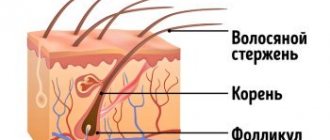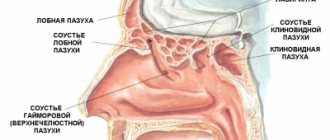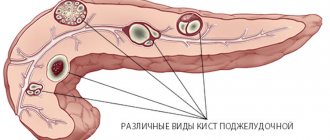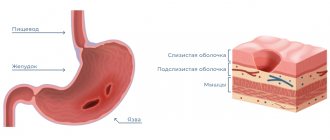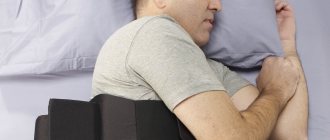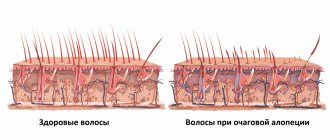Alopecia is hair loss that goes beyond the physiological norm, i.e. Alopecia means increased (not directly related to damage to the hair follicle) or pathological (related to damage to the hair follicle) hair loss.
As you know, in the life cycle of an individual hair there are several stages: growth, transition phase and loss. Under the influence of various factors, the duration of these phases can change, which leads to severe hair loss and baldness. This problem occurs in both men and women, and the success of treatment largely depends on the timeliness of seeking qualified, competent help.
Signs of alopecia
First, you need to understand that the amount of hair loss in women actually exceeds the norm.
For this purpose, you can conduct a test at home - carefully examine any lost hair. If one of its ends has a light bulb, then this will be considered a sign of the natural process of hair loss, that is, regeneration. You can also examine the hair on your head under good lighting. In most cases, the problem will be visually noticeable in the form of a widening of the middle parting. When the follicles stop functioning normally, the hair becomes thin and an excessive amount of hair appears on the comb. In addition to a noticeable widening of the parting and thinning of the hairs, among the symptoms in women, one can note a pronounced thinning of hair and in less than 5% of cases there is a complete loss of hair in certain areas of the scalp.
Recommendations and unique recipes for home use
There are a huge variety of traditional methods for treating alopecia, and it would be wrong to completely abandon them.
Onion juice for alopecia
Onion juice has a beneficial effect on hair growth, strengthens hair follicles, stimulates blood circulation, and has bactericidal and immunostimulating properties. In addition, onions contain vitamins and minerals important for hair, including sulfur.
Onion recipes:
- Place a towel soaked in very warm water on your head. After a few minutes, when the scalp is warm, apply pre-prepared fresh onion juice to it. After 30 minutes, wash your hair thoroughly.
- Mix 50 ml of honey heated in a water bath with a raw egg and grated medium onion. Rub the mixture into the hair roots for 30 minutes, then rinse thoroughly, using a mild shampoo.
- For seborrhea, you need to grind 2 cloves of garlic and one small onion into a paste, mix and apply to the hair roots for 30-40 minutes, then rinse thoroughly.
Bay essential oil for alopecia
Bay oil is made from the bark of the bay tree. It stimulates blood circulation, improves trophism of hair follicles and scalp, nourishes hair along the entire length, has antiseborrheic, antipruritic and antiallergic effects, reduces flaking of the skin and prevents split ends.
Bay essential oil is very easy to use. It should be mixed in a ratio of 1:10 (one part oil to 10 parts product) with any medicinal or care product, such as hair shampoo. Then use the product as usual.
Salt against alopecia
Treating baldness with salt has been known to people since ancient times. Salt cleanses the skin well, enriches the epidermis and hair with essential minerals, in particular magnesium, calcium, sodium, iodine and chlorine. Salt has antibacterial and antifungal properties, stimulates blood exchange and tissue regeneration. It is used for special massage, as well as for the production of various medicinal salt products.
Recipes using salt
- Apply a little sea salt to the scalp moistened with warm water and rub it in with gentle movements until completely dissolved. After this, rinse your hair with soft running warm water.
- Mix honey heated in a water bath with salt in a one to one ratio. Beat the mixture in a mixer until a homogeneous thick foam forms. Apply foam to hair roots and wait 30 minutes. Wash your hair with soft warm water.
- Heat 50 ml of honey in a water bath, mix with one tablespoon of cognac and 50 grams of salt, beat everything in a mixer and apply to the hair roots for 30 minutes. Rinse hair with warm soft water.
Salt must be used carefully, as it is not suitable for dry, brittle and damaged hair.
In reality, there are many more home remedies for treating baldness. There are simply countless of them. Some methods are recognized by official medicine, while others are considered dubious. But we can definitely say that an integrated approach to solving the problem, combining folk and traditional methods, will give the best result. However, in no case should you self-medicate or rely only on traditional medicine. Before starting treatment, a thorough examination must be carried out, the cause of alopecia must be identified, the hair type must be determined, and only then an individual course of therapy must be selected. You should not resort to traditional methods without consulting an experienced trichologist.
Classification of the disease
Signs of alopecia can appear for various reasons, and experts classify the disease itself:
- Natural alopecia is explained by changes in the stages of follicle growth. It slows down or speeds up depending on the time of year and the presence of stressful situations in life.
- The most common type of disease can be considered androgenetic alopecia in women, which is characterized by severe hair loss in the forehead and parietal area along the parting. Androgenetic alopecia is usually caused by the body's high sensitivity to the interaction of products produced by the sebaceous glands and testosterone.
- When the skin is damaged (diseases, injuries, cuts, cuts, burns), scars form, which cause cicatricial alopecia. Hair growth may stop completely due to severe damage to the hair follicles. In some cases, surgical intervention is required.
- Diffuse alopecia is uniform hair loss in women on all areas of the head. Most often occurs after a serious illness.
- Alopecia areata is expressed as hair loss in certain areas of the scalp. Most often, the disease is triggered by autoimmune processes in the body and requires complex treatment.
At the first stage of alopecia, the parting widens from the forehead to the parietal zone; at the second stage, hair thinning is clearly noticeable. If left untreated, hair may be completely lost.
Causes of baldness
Causes of alopecia may vary. Of these, the main ones are:
- heredity;
- physiological, external factors.
A hereditary factor is a person’s predisposition to the development of androgenetic alopecia. In genes, a serious change in information about the balance of androceptors and testosterone, necessary for physiologically correct hair growth, can occur. These changes are inherited by children, which causes early baldness.
Why does hair loss occur?
To restore hair follicles and start the normal regeneration process, it is important to find the causes of alopecia. This will help to identify negative influencing factors and eliminate them (if possible), as well as develop an effective treatment regimen. Let's look at the main reasons:
- hormonal imbalance during puberty, menopause;
- spread of fungal diseases;
- frequent stress, which slows down the processes of growth and nutrition, impairs blood circulation;
- chronic diseases that weaken the body;
- burns, injuries;
- radiation therapy;
- insufficient hemoglobin level;
- pregnancy, lactation, during which hormonal changes in the body occur, lack of vitamins;
- drying hair with a hairdryer, exposure to high temperatures;
- side effects after medical procedures, taking medications;
- diets, poor nutrition;
- hairdressing services - afro braids, dreadlocks, perms, hair extensions, tight hairstyles.
All these factors can affect the appearance of hair and lead to gradual baldness.
Diagnosis of the disease
If a problem is detected, you must contact a specialist who will conduct a comprehensive diagnosis or recommend contacting specialized doctors. The trichologist will conduct examinations:
- Computer diagnostics - trichoscopy, which allows you to analyze the condition of hair and skin, determine the phase and degree of hair loss, and detect genetic signs of alopecia.
- A phototrichogram allows you to quickly identify changes and diseases in the hair structure, confirm even the initial signs of androgenetic alopecia, monitor hair loss over time, calculate the percentage of hair in the growth stage, thinning and strong, and hair density.
- Dermatoscopy is performed to detect skin diseases and neoplasms.
Based on the results obtained, it is possible to suggest the causes of the development of alopecia and select further procedures and treatment. Additionally, tests are ordered to confirm or refute infectious diseases, thyroid dysfunction, and lack of important microelements. Before prescribing any cosmetic products or procedures, a test is performed to check for allergic reactions.
Treatment by a specialist
After assessing the condition of the follicles, the specialist will select measures to quickly and effectively eliminate alopecia. In particularly difficult cases, hair transplant surgery is recommended when the skin is no longer able to start the process of new hair growth. Women suffering from alopecia are prescribed cosmetic products that are aimed at eliminating the signs of baldness. The main component of such drugs, minoxidil, normalizes vascular function and has an antihypertensive effect. Minoxidil-based products are considered one of the most effective, and their regular use helps accelerate growth, increase density and increase the duration of the active growth phase.
The following procedures also help to cope with baldness:
- Scalp mesotherapy – injections with individual selection of cocktails based on indications. The injected compositions help to launch nutritional processes and saturate the follicles with useful microelements.
- Ozone therapy is necessary to quickly stop the process of hair loss and strengthen it, and its action is based on the influence of active oxygen molecules.
- The use of hardware treatment methods - darsonval, laser therapy, electroporation (saturation of nutrients using electric current, not needles).
Along with a set of procedures, many people need to take medications related to the restoration of hormonal levels. The prescription of such medications is not carried out by a trichologist, but by a doctor of the appropriate specialty.
How to help yourself at home
Despite the fact that procedures with a trichologist will be carried out regularly, you should take care of your hair and scalp daily at home. You will most likely have to abandon the use of shampoos and masks from the mass market, since exposure to sodium lauryl sulfate and parabens destroys the protein compounds of the hair and negatively affects its condition.
In the case of alopecia in women, the trichologist must individually select cleansing cosmetics for treatment, based on the degree of baldness and the probable causes of its occurrence. To help yourself quickly eliminate the problem of hair loss, follow these recommendations:
- If possible, eliminate stress and improve your sleep.
- Use local preparations based on extracts of nettle, peppermint, calendula, eucalyptus, zinc, magnesium, iron, vitamins B, E, castor oil. Treatment can be performed at home by preparing vitamin masks and sprays, but only in combination with techniques with proven effectiveness.
- Diversify your diet by adding meat, fish, vegetables and fruits, legumes, cereals, nuts, and vegetable oils.
- Lightly massage your scalp with your fingers to improve blood circulation.
- Avoid metal combs.
It is worth understanding that at the time of treatment it is necessary to completely exclude complex hairdressing procedures for women in the form of coloring, keratin restoration, styling, and curling.
Prevention
Since alopecia occurs in children and adults, preventative measures are important for people of any age. These include:
- maximum health control;
- healthy lifestyle: a nutritious balanced diet, giving up bad habits;
- proper hair care. They should not be over-tightened, combed too aggressively, or exposed too often to paints and other chemicals. Remember that scalp health is just as important as the hair itself;
- avoiding hot water when washing your hair. It should be a little cool, but comfortable;
- protection of the head from the cold during low temperatures, frosts and winds.
These simple ways will help avoid alopecia in men, women and children - or at least reduce the risks of developing such a problem.
